Violet Made of Thorns: The Prophet's Curse
Reading Time: 12 min
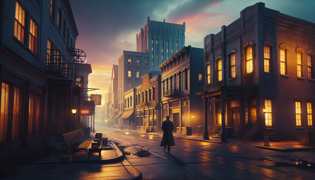
About Story: Violet Made of Thorns is a from united-states set in the . This tale explores themes of and is suitable for . It offers insights. A dark drama about a prophet, a curse, and unexpected attraction, exploring themes of truth and consequence.
Introduction
In the languid hours of dusk, when the American sky wears a cloak of bruised purples and ashen greys, the small town of Bellamy’s Crossing seemed to hold its breath. Here, legends were not merely bedtime stories; they were woven into the very fabric of cracked sidewalks and timeworn storefronts. The air carried anecdotes of a cursed seer—an enigmatic prophet burdened with visions of calamity and anguished truths. His name, whispered in fearful tones over flickering diner lights and midnight radio broadcasts, was Carver. Born under a wandering comet, Carver’s eyes had been marked with the deep sorrow of unspoken futures, an eternal witness to both beauty and despair.
On nights such as this, under a reluctant moon, Carver wandered the deserted lanes like a forlorn spirit. His footsteps were measured, as if each step sank into a mire of destiny. Every face he passed seemed to mirror a fragment of his own haunted reflection—isolated souls burdened by their hidden scars. The pulse of the town lay slow and heavy, beset by secrets too terrible to share aloud yet too potent to ignore. In the interstice between fading day and the encroaching dark, whispers of a prophecy met every gust of wind as if they were carried on ancient breaths.
In this liminal space, where shadow and light fused into an unsteady harmony, fate prepared its next act. Unbeknownst to Carver, the night would soon shatter the familiar cadence of despair with the fragile, defiant bloom of something unexpected—a name that glimmered like a solitary star amid a troubled sky. It was the promise of change, of reckoning, laced with both danger and hope.
The Prophet’s Burden
Carver had never intended to be a prophet. The weight of foresight was never his choosing, yet it had become his ceaseless companion. Born beneath extraordinary omens, his childhood was encircled by inexplicable coincidences and subtle portents that both awed and tormented his family. In his adolescence, every vision was a cold reminder of an inevitable tragedy, and by the time he reached manhood, the prophecies had eroded the simple joys of mortal life.
The town of Bellamy’s Crossing knew him since his earliest days as a troubled child, drawing murmurs of both pity and dread. Neighbors would huddle behind drawn curtains, fearful that his eyes might reveal secrets too cruel for daylight. Carver’s days were spent traversing ancient library archives, pouring over manuscripts and lore in pursuit of an elusive release from his cursed fate. Every prediction felt like a dagger pressed against the pulse of time, each one leaving behind scars of regret and shattered hope.
In a modest study lined with battered books and snatches of yellowed parchment, Carver would sit for hours in the pale candlelight. Here, the stark silhouettes of relics and artifacts formed a chiaroscuro tapestry that mirrored his own internal conflict. His only solace was found in the quiet solitude of forgotten places, yet in those moments, the curse seemed to whisper more insistently. The visions, both brutal and beautiful, manifested in bursts of symbolism: a wilting rose, a broken mirror, or a tattered piece of fabric that echoed the aching threads of destiny.
Night by night, Carver’s reputation grew, not as a man with a savior’s gift but as one condemned to trail disaster. His prophecies, uttered in a voice that trembled with a blend of resignation and defiance, were delivered in crowded town halls and desperate whispers in dimly lit corners of the local diner. Even as tragedy followed his words like a vengeful specter, Carver clung stubbornly to the idea that understanding the curse might one day free him. Each tortured premonition was a page in an ongoing chronicle of guilt, isolation, and the relentless pursuit of truth—a truth that became as much a prison as it was a revelation.
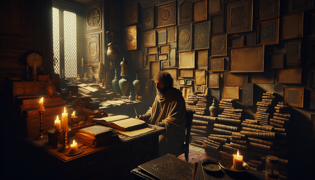
The Enigmatic Encounter
It was on an unusually still autumn evening that Carver’s solitary path intersected with that of Violet. The town was preparing for its modest harvest festival when a soft, unexpected luminescence began to filter through the gathering dusk. In the gentle hush of the evening, as families adorned in simple yet earnest garb moved about with cautious optimism, Carver found himself inexplicably drawn to the old stone bridge that overlooked a murmuring creek.
There, standing like a figure sculpted from twilight itself, was a woman whose presence defied the weariness of the world. Clad in a flowing garment of deep indigo and violet that fluttered with an almost spectral grace, her eyes shone with an inner light that belied tragedy and fortitude. The townsfolk had long spun fables about a mysterious spirit with both a healing touch and a dangerous allure, and though Carver had heard these whispers, nothing in his many desolate nights had prepared him for the tangible immediacy of her aura.
For Violet, the moment was no less profound. A quiet observer of life’s relentless cruelty, she had chosen solitude and careful detachment as shields against a painful past. That night, under the delicate interplay of lantern light and the remnants of daylight, a fragile connection sparked between them—a recognition of shared solitude and the faint promise of absolution. Their first words were few and halting; a mutual nod, the softness in their eyes, the almost imperceptible brush of hands as they exchanged a token of compassion.
In that brief encounter, the world around them seemed to blur into insignificance. The sound of laughter from distant celebrations, the clamor of everyday chores, even the scuffle of restless animals—all faded into a hush that spoke of urgent, unspoken mysteries. Carver saw in Violet not just the reflection of his own sorrow but also the specter of hope. And Violet, witnessing the silent torment etched on his face, felt a mysterious pull—the kind that arises when two souls, both adrift in despair, glimpse the possibility of redemption in one another’s eyes.
Their meeting, set against a backdrop of muted autumn hues and the soft murmurings of the creek, ignited in both an unfamiliar longing and an inexplicable dread. For in that delicate balance of attraction and foreboding, they sensed an echo of a destiny written in the secret language of stars—a destiny that might well bind their fates in ways neither could escape.
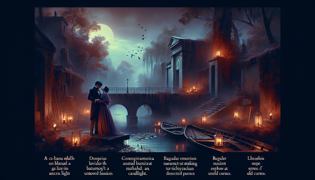
The Binding Curse
In the weeks that followed their fateful encounter, the bond between Carver and Violet deepened, weaving together threads of compassion, defiance, and an all-consuming curiosity about their entwined destinies. As Carver began recounting fragmented visions of wrath and redemption, he noticed a recurring symbol in each: a blooming violet wrapped in thorny vines, an image that echoed the very name of the woman who had so unexpectedly captured his heart.
Late one rainy evening, while the town lay silent under a watery canopy, Carver invited Violet to his secluded reading room—a dark, wood-paneled sanctum where dusty texts and esoteric symbols held the secrets of past generations. In that room, with rain tapping distantly on leaded windows and candle flames dancing in anxious shadows, the two delved into ancient manuscripts that chronicled cursed prophecies and the eternal struggle between fate and free will. Violet, whose own past was marked by inexplicable scars and whispered rumors of an ancestral burden, found a reflection of her inner turmoil within the cryptic passages.
The curse, it seemed, was not solely Carver’s to bear, but a malignant web that tethered both their souls to a destiny that promised both calamity and elusive liberation. As pages turned under trembling fingers, the symbols all converged into an inescapable conclusion: their meeting was no accident but a deliberate act of cosmic retribution—a reckoning for sins long buried. In a moment of both terror and clarity, Violet confessed that she too had been haunted by visions—a spectral presence urging her to seek out the one marked by prophetic sorrow.
Their mutual confessions unleashed a torrent of emotion that mingled love with dread. The curse revealed itself not only in the ominous warnings of ruin but also in the undeniable magnetism between them, as if their very union was a sacrament to a higher, albeit cruel, design. The boundaries between attraction and affliction blurred, producing moments of both sublime intimacy and heart-wrenching isolation. As Carver’s heart pounded with both hope and despair, he understood that the truth of his prophecies now bore a personal price: to truly love Violet meant embracing the curse, with all the painful revelations and unalterable consequences it entailed.
As thunder rolled in the distance and the night deepened, the room became a crucible of conflicting forces. The two souls confronted the duality of their fate—the seductive allure of redemption shadowed by the barbed pain of inevitability. In that charged moment, every whispered secret and every shared look affirmed that whatever path they chose, they could no longer hide from the shadow of destiny.
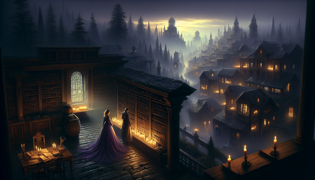
Confronting Fate
As autumn yielded to the unease of early winter, the air in Bellamy’s Crossing thickened with tension and the palpable weight of forewarned calamity. Rumors swirled in hushed tones through the streets and alleyways—a curse that had long marred the town’s history was now at the brink of manifesting in its most violent form. Carver, bolstered by the strength of his newfound connection with Violet, sought to confront the dark destiny that had haunted him for so long.
Under a slate-gray sky and amidst battered streets that now bore the scars of time and neglect, a decisive confrontation was coming to a head. Carver and Violet stood together before a gathering crowd in the town square—a mosaic of fearful eyes and trembling voices, all yearning for an explanation as to why their lives had become entangled with relentless misfortune. The meeting was charged with an almost tangible electricity. Lanterns swung overhead and the cold breath of winter crept into every corner of the square. It was here that Carver, once resigned to his fate, proclaimed the truth of his visions: that the curse was not merely a harbinger of doom but also a call to acknowledge the raw, unspoken truths of life.
He spoke of destiny as a tapestry woven with threads both beautiful and sinister, of how each life, though marred by pain, could also be the site of redemption if only one dared to confront their inner darkness. His words, laced with the sorrow of countless lost dreams and the fierce yearning for vindication, stirred both empathy and anger among those gathered. Yet even as the crowd murmured, a sudden force of opposition emerged—a faction of townsfolk, desperate to cling to the comfort of ignorance, incited old superstitions and threats of violence. Amid the clamor, Violet stepped forward, her voice soft yet unwavering as she defended the right to face one’s fate with both humility and hope.
In that fraught moment, the curse itself seemed to pulse with a malevolent energy, as if the very air were charged with the consequences of unaltered truths. A violent gust of wind sent fallen leaves swirling, and in the mix of chaos and courage, both Carver and Violet found themselves at the center of a reckoning. It was a confrontation not only with the judgment of a fearful crowd but with the legacy of their own sorrows. With faces stricken by resolve and eyes alight with defiance, they embraced the paradox of their existence—knowing that the path to redemption was steeped in sacrifice, that to change one’s fate was to accept every painful shard of one’s past.
As the tumult of the square crescendoed into chaos, the two stood hand in hand against the storm. The fury of the mob, the bitter rain, and the unforgiving winds bore witness to a truth that was as ancient as the curse itself: even in the depth of despair, love and courage could ignite the light of change.
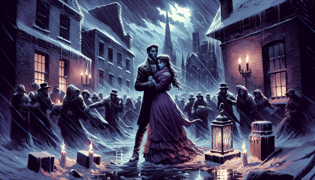
Conclusion
In the aftermath of that tumultuous night, as the echoes of clashing voices slowly faded into disquieting silence, Bellamy’s Crossing found itself suspended in a delicate balance between despair and hope. The storm that had swept through the town left behind scars, both tangible and emotional. For Carver, the prophet whose every word had once been a harbinger of doom, the confrontation marked a turning point—a painful yet essential step toward accepting the multifaceted nature of truth. The curse that had long haunted him was not vanquished by the clamor of angry crowds or the weight of ancient sins, but it was transformed by the very act of confronting it.
Beside him, Violet remained the luminous counterpoint to his darkness. Together they had embraced the bitter inevitabilities of fate, and in doing so, they discovered that redemption lay not in the absence of pain but in the acceptance and understanding of it. In the quiet that followed, their union became a whispered promise of renewal—a defiant, tender rebellion against a destiny written in sorrow.
Over the ensuing days, as the town slowly stitched itself back together, Carver and Violet retreated into a modest refuge at the edge of the woods. Here, amid the soft murmurs of nature's recovery and the gentle caress of a forgiving dawn, they spent long hours poring over forgotten texts and reflecting on the events that had reshaped their fates. Each sunrise brought with it a fragile peace, each sunset a reminder of battles fought and lessons learned. The curse, while still an integral part of their shared existence, had evolved into a testament to the resilience of the human spirit—a spirit capable of finding light even in the darkest of prophecies.
It was in this tempered light that the couple began to forge a new narrative, one where the truth was both a burden and a beacon. Their journey, marred by sorrow yet illuminated by unexpected love, left an indelible mark on Bellamy’s Crossing—a reminder that even in the presence of curses and consequences, the human heart holds the power to transform fate into hope.

















